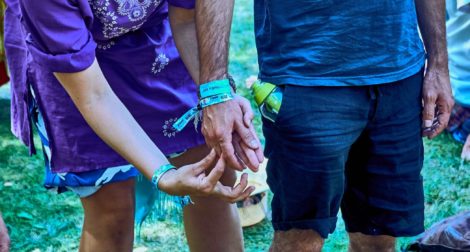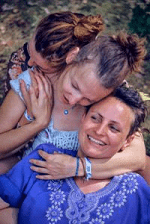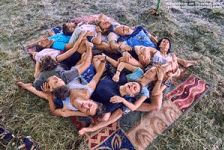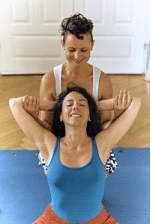

Touch – the ingredient of happiness
You may have heard of a study by a psychologist Virginia Satir, which proves that a child needs four hugs a day to survive, eight to feel good and twelve to develop. But is it just children who need a kind touch to feel good? Do you grow out of the need to cuddle?

Of course not! Many scientific studies indicate that touch has a positive impact on the health and well-being of people of all ages. The most important effects are:
• Increased feeling of happiness and life satisfaction. Happiness is a multidimensional phenomenon that is hard to measure, but physiology shows that touch causes an increase in the level of such hormones as oxytocin (love hormone), dopamine, serotonin (happiness hormone), which are responsible for making us feel happier.
• Stress reduction – touch regulates the body level of cortisol, a hormone that is secreted in stressful situations and often remains high even after the stressful situation has ended, which adversely affects a persons’ health and well-being.
• Increased immunity – applying pressure stimulates the secretion of white blood cells that help fight viruses and bacteria.
• Positive impact on the perception of yourself and your body, as touch increases self-esteem – from the very beginning our parents’ touch tells us that we are important and unique. This pattern is stored in the body for the rest of our lives, and we can influence our self-esteem through cuddling and massage.
• Satisfying other important psychological and social needs: sense of closeness, community and belonging.
Knowing that touch has such a positive effect on our well-being, we can use it as a mean to overcome bad mood in the autumn. It’s getting colder and colder, and our skin and eyes are getting less and less sun. It’s worth making up for these deficiencies and prevent mood drops before the energy falls below the critical level. If you have a friend, child, family or a dog nearby – hug them more often!
Self-massage: practical tips
To enjoy touch, it is not necessary to have anyone nearby, because we always have… ourselves! Self-massage, or massaging yourself, is able to provide us with many benefits with very little effort – we just need some time and mindfulness. If you don’t really know how to do it, sit back and start with your foot. The massage pattern is always the same:
– warm-up, greeting: stroke the entire surface of the foot and each toe individually
– intensive part: rub with your fingertips or with your whole hand, knead, apply pressure with your thumbs (there are many active points on the sole of the foot, pressing which stimulates self-healing processes in the body), shake, pat;
– closing: silencing stroking at the end.
The same pattern can be used on calves, thighs and abdomen. Massage of the face and head is especially nice and relaxing. Here, it is worth to focus on stroking and gently rubbing with your fingertips. For a successful self-massage, you don’t have to know many techniques, the important thing is to listen to yourself and your feelings. Thanks to the fact that you can feel how it works when massaging, you are able to intuitively give your body exactly the kind of stimulation it needs at the moment. If you need more technical guidance – YouTube is a source of knowledge on this topic as well. Time turns out to be the biggest challenge during self-massage: we instinctively rush, and we do not give ourselves these 10-20 minutes of attention.
Self-massage has a lot of advantages, but I value one of them the most – you can do it on the train, in the cinema, in the dental waiting room – wherever we sit down and have some time to spare!
Bodywork: between massage and hugging
 Bodywork is a very broad field covering work with the body through touch (massage, manual therapy), energy and breathing practices. Reading this description, we usually think about working on a one-on-one basis with the therapist, but it does not always have to be the case. The exploration of touch and its impact on our body can also take place in a workshop, which is less formal and gives more space for your own discoveries and insights. Bodywork in the form of massage and movement exercises is used by both professionals (dancers, actors, acrobats, etc.) and people who do not work with the body professionally, because bodyworks have considerable developmental and health potential and are simply relaxing and pleasant.
Bodywork is a very broad field covering work with the body through touch (massage, manual therapy), energy and breathing practices. Reading this description, we usually think about working on a one-on-one basis with the therapist, but it does not always have to be the case. The exploration of touch and its impact on our body can also take place in a workshop, which is less formal and gives more space for your own discoveries and insights. Bodywork in the form of massage and movement exercises is used by both professionals (dancers, actors, acrobats, etc.) and people who do not work with the body professionally, because bodyworks have considerable developmental and health potential and are simply relaxing and pleasant.
An example bodywork task can look like this: in a randomly matched pair one partner lies on the floor, closes their eyes and focuses on the sensations flowing from the body. The other partner massages their arm, starting from stroking, kneading, shaking and patting the muscles, then raises the massaged arm and begins to move it, checking the functioning of the limb (as if they saw such a structure for the first time), thus dancing an improvised dance. After 10 minutes, the partners switch roles. During this task, the passive partner receives a mini-massage and the interesting experience of being danced by someone else, their body gets to know new moves, and the active partner has the opportunity to create and open their curiosity to the world. At the same time, they both receive a solid dose of touch, so they become healthier and happier!
This is just an example, there are a lot of workshop bodywork tasks. The task can be focused on relaxation (physical relaxation, building a micro-relationship with a partner), on motor research (e.g. examining how the force of gravity works in this system of bodies) as well as on psycho-sociological aspects of touch (e.g. observation of own patterns in relationships). Bodyworks are actively used in contact improvisation classes, acroyoga, work with the body using the methods of A. Lowen or M. Fieldeldkrais and other physical and therapeutic classes.
If you are in Warsaw, I encourage you to attend “Zadbaj o siebie” (“Take care of yourself”) workshop series, where, apart from movement and meditation, we will practice bodywork to give our bodies a solid dose of touch. The body likes touch, it likes to be kneaded, shaken, stroked. And it is so simple that under the supervision of an instructor everyone can offer a touch to anyone without much preparation. All you need is good intentions and paying attention to your partner.
Massage – a professional touch

The human body is an extremely complicated system, so deeper work with touch requires anatomical knowledge, knowledge of both massage techniques and the specificity of the massaged body: its diseases, injuries, current needs. At the same time, massage has a lot of good to offer. In addition to all the benefits of touching (increased immunity and sense of happiness, reduction of stress), massage also has a positive effect on each of the body’s systems, in a nutshell:
• circulatory and lymphatic system – improves blood and lymph flow, improves and makes vessels more elastic, stimulates metabolism;
• muscular system – reduces tension, supports the nutrition of muscle fibres, increases their elasticity and firmness, which translates into an increase in muscle performance;
• respiratory system – relaxes, makes the respiratory muscles more elastic, increases blood flow through the lungs;
• skeletal system – nourishes and prevents degeneration, increases joint mobility;
• nervous system – stimulates nerve conduction, regulates the functioning and cooperation of sympathetic and parasympathetic systems.
Listing the impact of massage on individual body systems, we use the Western, anatomical-physiological approach, which is the basis of the classical massage. At the same time, there is an Eastern approach, perceiving massage as a tool for improving the flow of energy in the body, releasing emotions and accumulated experiences, stimulating self-healing processes, restoring energy balance. Eastern practice has been shaped parallel to the development of Eastern medicine and philosophy, and it treats massage as work not only at the physical, but also at the spiritual level. For example, Thai massage, being a physical expression of kindness, is based on the teachings of Buddha and using the knowledge of Traditional Chinese Medicine and Ayurveda. It is a holistic approach, treating a person as a physical-spiritual whole.
When to avoid massage and intensive touch?
In some cases, both massage and self-massage are inadvisable. The main contraindications are fever or other inflammatory process in the body, which can be intensified after the massage – the massage accelerates all processes in the body, including adverse ones. It is also not a good idea to massage wounded or infected skin. The exact list of contraindications for massage is longer. It is worth consulting a masseur before the procedure or listening to yourself more carefully – if we listen to your own bodies, we are able to feel what will be good for us and what will not.
The body is wise, and all you have to do is give it time and space and direct energy where it is needed most. Touch creates such a space, a space of mindfulness.
Join Nadia’s workshops at Festiwal Wibracje – see the programme.
The author:
 Nadia Szypiłow – speaker at Festiwal Wibracje. Certified masseuse (Thai and classical massage), performer, practitioner of bodynautics. Through the “Ciao, Ciało!” project, she popularises bodynautics – extending body awareness through movement, massage and bodywork, somatic practices, breathing, etc. Bodynautics refers to the physical here and now, activates natural curiosity and creativity, which brings pleasure, vitality and a better connection with yourself.
Nadia Szypiłow – speaker at Festiwal Wibracje. Certified masseuse (Thai and classical massage), performer, practitioner of bodynautics. Through the “Ciao, Ciało!” project, she popularises bodynautics – extending body awareness through movement, massage and bodywork, somatic practices, breathing, etc. Bodynautics refers to the physical here and now, activates natural curiosity and creativity, which brings pleasure, vitality and a better connection with yourself.
Photos: Andriej Szypiłow
Redakcja;17:39; 23.11.2019







